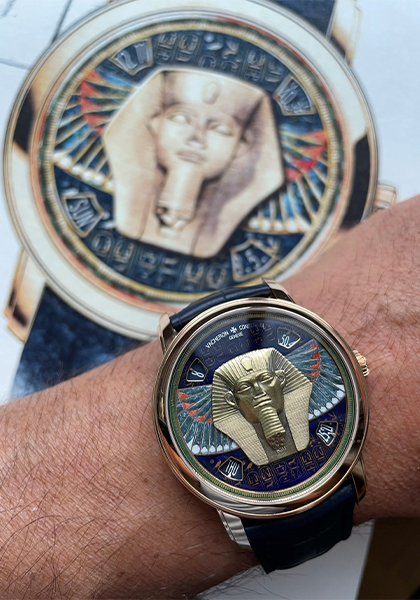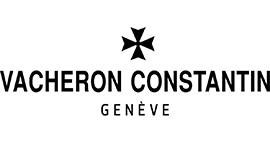How did the idea for the partnership with the Louvre come about?
The idea had been germinating for quite a long time, because Vacheron Constantin has a long history of working on cultural projects. In 2016, we were fortunate to be involved in the restoration of a very fine post-renaissance clock called “The Creation of the World”, with the Louvre. Our know-how on the subject meant that the project was concluded to the great satisfaction of both parties, and this naturally gave rise to discussions about the possibility of a strategic partnership. The Louvre was interested in talking about collaborations based around know-how, workshops and rare crafts. Their team includes artisans who are constantly restoring palaces, salons and furniture, along with others whose job is lighting, or installing artworks. Through these exchanges we discovered many points of similarity between our two institutions, beyond just our advancing years! We decided to work together around a number of focal points: preservation of artistic crafts and rare specialisms; preservation of heritage, in the sense of maintaining our past in such a way that we can share it; and finally joint creation of new works. As civilisations are one of the Louvre’s specialities, and artistic crafts are one of ours, we decided to work in depth on the great civilisations and the works that represent them best, with the aid of experts and creators from the museum, with a view to creating four watches in a limited series.
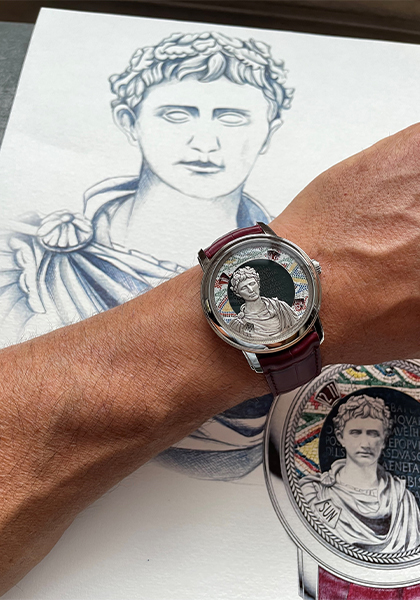
Which other museums have you worked with in the past?
We have had cultural partnerships with the Opéra Garnier, for example, and the Musée Barbier-Muller, which led to the Métiers d’Art watches “Chagall & l’Opéra de Paris” and “Les Masques” respectively. But this is the first time we have collaborated on such an extensive creative project. The work was carried out jointly by Vacheron Constantin’s heritage and design departments, alongside staff from the Louvre. To our knowledge this is a first, and it’s also the first time that these works have been interpreted in this way. Each watch pays tribute to one of the four great civilisations of the ancient world: Ancient Egypt in its Golden Age; Mesopotamia and Babylon in the Persian Empire; Ancient Greece in the Hellenic period; and Rome at the time of Emperor Augustus.
Who selected the works to represent each civilisation?
Experts from the Louvre proposed major works from each period, and told us about the techniques that would have been used at the time. At the same time, we provided recommendations on the best métiers d’art techniques to remain faithful to the original. The watches come with a certificate from the Louvre, stating that the reproduction is faithful to the spirit of the original work, and to the wishes of the technical teams of the Louvre, for whom these works represent a genuine historical treasure.
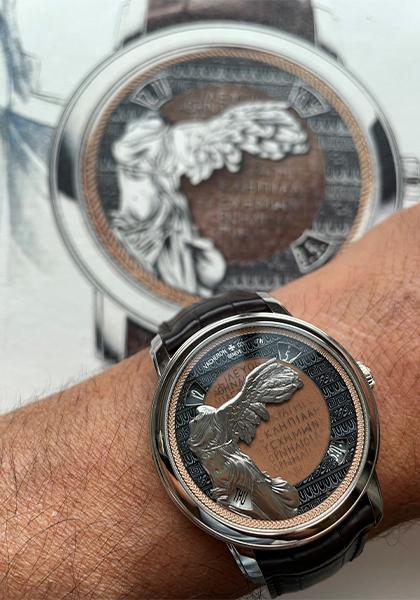
Could you give an example?
Let’s take the Lion of Darius from the Frieze of Lions, a mural made from glazed siliceous bricks, found in the first courtyard of the palace of Darius I in Susa, capital of the Persian Achaemenid Empire, in the south-west of what is now Iran. We used a very rare stone marquetry technique, which posed a huge challenge. Vacheron Constantin employs many artisans, both in-house and from its network of external experts, but they mainly work with enamelling, engine-turning, engraving and gem-setting, and sometimes wood and straw marquetry. We were delighted to be able to work with this craft again, in the context of Mesopotamian culture. To accentuate the realism of the brick construction, the artisans chose fragments of semi-precious stones, turquoise and mookaite jasper, that were different in appearance and size, with clear veining, which made them more fragile by definition than purer samples. They were very carefully arranged to give the impression of a cracked wall, which was an immensely complex tax. In addition to stone marquetry, this piece includes a number of different elements – the lion sculpted from patinated gold; the frieze engraved in metal; champlevé enamel with inclusions to create an aged effect; cuneiform letters engraved on the sapphire crystal – which add incredible depth and texture to the dial. On the watch featuring the bust of Augustus, the stone mosaic comprising 660 minute stones measuring 0.5 mm square is also a utterly exceptional achievement, and might well inspire further pieces down the line. It took two years to create these watches and bring the concept to fruition. Everything is coherent. The curators patiently validated each element of the watch decoration, including the hieroglyphics, as well as the friezes. Each watch has its own complete and authentic narrative, expressed through craftsmanship and the métiers d’art.
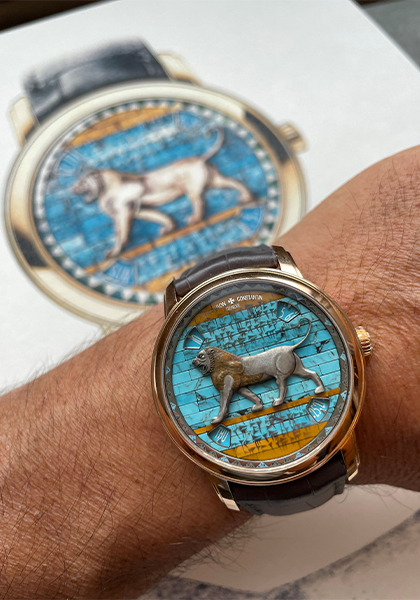
Are you concerned about the impression of elitism inherent in partnerships like this, and such limited series?
These pieces are indeed very complex to produce and very rare. As always, we endeavour to ensure the highest possible quality and the most refined aesthetic in our creations, which is why their production remains extremely limited. This underlines our wish to conclude a partnership that is less mercantile and more message-based. In this instance, the message is about Vacheron Constantin’s traditional and strongly held reverence for culture, in all its forms and from every origin. For those familiar with the company, François Constantin was a keen traveller who opened up to China and the Americas even before approaching Switzerland’s neighbouring countries. Vacheron Constantin has always drawn inspiration from beautiful things, all over the world. The collections of the Louvre are far more than just the Mona Lisa, and we delved into their archives to explore how craftsmanship can restore the beauty of the works of the past. The second key message lies in the collaboration in terms of métiers d’art, between the Louvre and Vacheron Constantin, and it shows that the work accomplished by our artisans is not so very different from that of artisans working for museums, or even from the artists who created these masterpieces in centuries past. Finally, the message also underlines Vacheron Constantin’s ambition to be a watchmaking house with which the Louvre – the pinnacle of prestige and credibility – could agreed to work, and it is an indication that our work is of the highest standard.
